Even with a quick glance at the photos on this page, it becomes obvious that a smile is a signal of pleasure emotion. Fun,
fiero ,
naches , satisfaction, excitement, sensory pleasures, relief, amazement,
schadenfreude , ecstasy, and perhaps
elevation and gratitude - all these emotions imply a smile. These smiles can vary in intensity, speed of appearance, duration of preservation on the face and the speed of their disappearance.
If all these pleasant emotions suggest the appearance of a smile, how do we know which one is being tested by another person? A recent study, mentioned in Section 4, reinforces my intuitive conclusion
[197] that it is the voice, not the person, that gives the signals that distinguish one pleasant emotion from another. English psychologists Sophie Scott and Andrew Calder identified different voice signals for satisfaction, relief, sensory pleasure from touching and
fiero . They found that a man signals these emotions with his voice; reproducing each such beep, they found that a person with no hearing problems can distinguish one emotion from another. So far, they have not yet fully figured out what exactly in the sounds of the voice signals each of these emotions of pleasure. I expect them to identify voice signals for other pleasant emotions.
Smiles can be misleading, not only because they arise along with each of the emotions of pleasure, but also because they appear when people have no pleasure, and smile, for example, only out of politeness. There is one feature that allows you to distinguish smiles of pleasure from other smiles. This is a very subtle feature, and a study I did with psychologist Mark Frank indicates that most people do not notice it.
[198] If you don’t know what to look for, then you may be misled, confused, or conclude that smiles are not very reliable signals of emotions. But this is not the case; Smiles unequivocally, although barely noticeably, tell us whether they are caused by the enjoyment they receive or not.
More than a hundred years ago, the great French neuropathologist Duchenne de Boulogne discovered how a real smile of pleasure differs from all other smiles.
[199] He studied how each face muscle changes the appearance of a face by electrostimulating different parts of the face and then photographing the results of muscle contractions. (A man who did not feel pain on his face and did not experience anxiety during electrical stimulation participated in his final experiment.) When Dushen was looking at a photo of a smiling man obtained by stimulating what is called a
zygomatic major , i.e., a large zygomatic muscle (it comes from cheekbones down at an angle to the corner of the lips, pulling him up while smiling diagonally upwards, he noticed that this man really did not look happy. Being an experienced experimenter, Duchesne told this man a joke and filmed his reaction. Comparisons of images showed that in the case of real pleasure, manifested in the reaction to the anecdote, the person did not just smile, but also activated the muscles that surround the eyes (
orbicularis oculi , or the circular muscle of the eye). You can compare the picture in which the person has electrodes on the face (left), with a picture without electrodes, in which the person smiles in response to the anecdote (right).
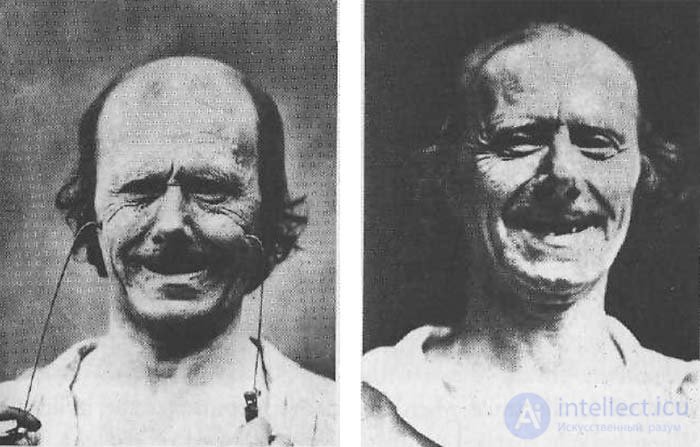
Duchene wrote: “Emotion of sincere joy is expressed on the face as a result of joint muscle contraction of
zygomaticus major and
orbicularis oculi . The first submits to the will, but the second is activated only by the pleasant emotions arising in our soul [remember that these words were written in 1862] ... feigned joy, insincere laughter can not cause contraction of the second of these muscles ... Muscle located around the eyes does not obey the will; it is driven only by a true feeling, a pleasant emotion. Her inertness, which manifests itself when a smile arises, makes it possible to expose an unfaithful friend. ”
[200] Our study
[201] confirmed Duchene's assumption that no one can intentionally cause muscle contraction of the
orbicularis oculi (it “does not obey the will”), although it is only a part of the muscle whose contraction is difficult to cause intentionally. This muscle consists of two parts: the inner part, which stretches the eyelids and the skin directly beneath them, and the outer part, which controls everything that is located around the eye socket, tightens the eyebrows and the skin below them, tightens the skin under the eyes and lifts the cheeks . Duchene was right about the outer part of this muscle: very few are able to intentionally cause its contraction (only about 10% of the people we examined).
The inner part of the muscle, stretching the eyelids, can be reduced by us deliberately, and therefore the absence of its contraction cannot “expose an unfaithful friend.” Actors who are able to convincingly portray pleasure on their faces, either belong to the small group that can, at their own discretion, cause a contraction of the outer part of the muscle, or, more likely, they recall what generates a pleasant emotion, and then this emotion creates face sincere unintended expression.
Although Charles Darwin quoted Duchene and used some of his photographs to illustrate the differences between smiles, scientists who studied facial expressions for the next hundred years ignored Duchene's discovery.
[202] We, together with my colleagues, re-introduced the discovery of Duchene to the scientific world twenty years ago
[203] and have since been actively demonstrating its importance. For example, when a stranger approaches a ten-month-old baby, the child’s smile will be created without the muscles located around the eyes; However, these same muscles will be involved in creating a smile on the face of the baby, when his mother approaches him.
[204] [205] When happy married husband and wife meet in the evening after work, their smiles are created with the participation of the muscles of the
orbicularis oculi , but the smiles of the unhappy married spouses are created without the participation of these muscles.
[206] People who are able to talk about the recent death of their spouse (spouse) and show the smile created by the circular muscles of the eyes cease to experience grief after two years.
[207] (This does not mean that they rejoice at the death of their spouse; they are just able to remember pleasant events from their life together and for a moment to relive the happy moments.) Women who showed a smile in their college graduates photos circular muscles of the eyes, thirty years later were less likely to report their misfortunes and showed more signs of general moral and physical well-being.
[208] In general, those people who often show a smile created by using the circular muscles of the eyes felt happier, had lower blood pressure and were reportedly happy with their relatives and friends.
[209] Our own research allowed us to establish that the smile created by the eye muscles and lips activated those areas of the brain (left temporal and posterior sections) that are activated when receiving spontaneous pleasure, and the smile only through lips did not provide such activation.
[210] I suggested that, in honor of this outstanding scientist, we call that genuine smile of pleasure, in the creation of which the outer part of the muscles of the
orbicularis oculi participates, be called
Dushen's smile.
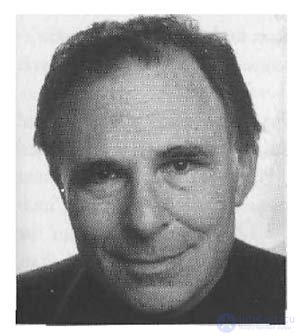 | 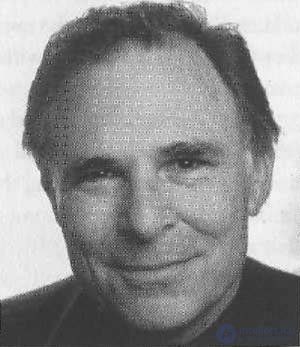 |
| BUT | B |
At first glance, it may seem that the only difference between these pictures is the more squinted eyes in picture B, but if you carefully compare these photos, you will notice other differences. In the picture B, showing real pleasure, expressed with the help of Dushen's smile, the cheeks are higher, the outlines of the cheeks have changed, and the eyebrows are slightly lowered. All this happened under the influence of the outer part of the circular muscles of the eyes.
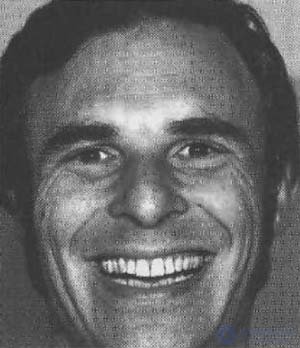 | 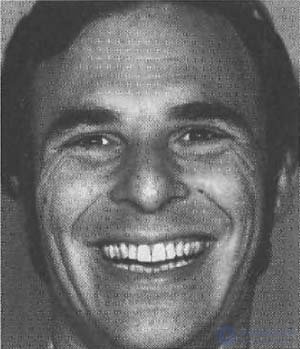 |
| AT | R |
When a smile is wider, there is only one pointer to the difference between a smile caused by the pleasure being experienced, from other smiles. A wide smile like the one shown in picture B lifts the cheeks up, gathers the skin under the eyes, reduces the opening of the eyes, and even causes wrinkles called “chicken legs” - all without the help of the
orbicularis oculi muscles.
For comparison, the image D shows how the skin fold between the eyebrows and eyelids tightens downwards under the action of the circular muscles of the eyes. Picture D shows a wide smile caused by the pleasure being experienced, while picture C shows a wide smile, but caused by some other reason. Snapshot B is a composite photograph obtained by overlaying a part of the face below the lower eyelids, taken from snapshot D, onto a neutral snapshot D. Snapshot E is another composite photograph; it is obtained by superimposing a neutral snapshot D of smiling lips from snapshot G.
 | 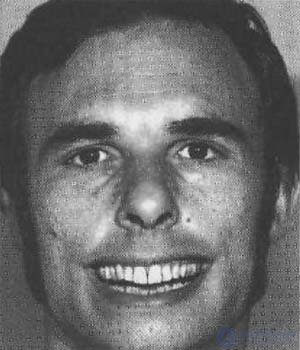 |
| D (Neutral) | E |
The person is not able to give the face the expression shown in the picture E. This should seem strange to you for the reason that when the smile is so wide, it causes all the changes in the cheeks and eyes that you see in the picture D. I took this composite photo to emphasize the fact that very wide smiles change not only the lips, but also the cheeks and the appearance of the skin under the eyes.
There are many different smiles caused by other reasons besides pleasure. Some, like a smile of courtesy, involve the use of only smiling lips. This position of the lips is also observed in smiles, indicating that the listener understands and approves the words of his interlocutor. Some smiles, not caused by the pleasure experienced, require other facial movements besides lip movements that express a smile.
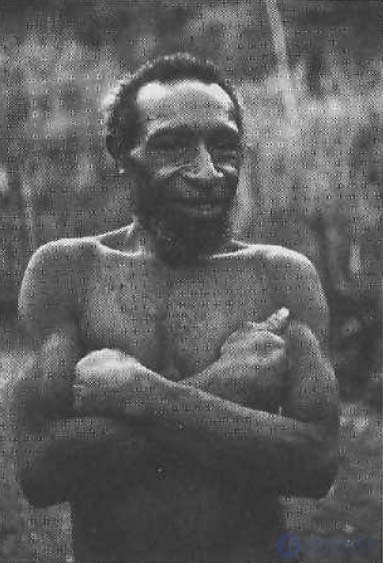
Indecisive or cautious smile This resident of New Guinea is considered a respected man in his village. His indecisive or cautious smile signals that he is not thinking about causing harm, but he is not yet sure what might happen next. I seemed to the inhabitants of this village to be a very unpredictable person who did strange things: smoking a cigarette from matches, using an electric torch, extracting music from a magic box. This man first encountered such miracles and felt attracted to me as a source of surprise, excitement and fun, but he couldn’t know when I could cause him fear or awe him. The lips opened in a smile and arms crossed on the chest help to convey his indecision.
Poignant remarks fell on the president all day. Ronald Reagan finally ended his speech at the National Association for the Advancement of Colored People (
NAACP ) conference, but when she delivered the opening speech, Barbara Bush Wilson, who chaired the conference, pricked it several times, reminding the audience that he did not appear at the association’s congress during presidential campaigns. She also caused an explosion of fun among delegates by making the following statement: “The
NAACP will not necessarily sign under all the statements that will now be made.” After completing his speech, the president firmly hugged Wilson and showed on his face what could be called an unhappy smile, or a smile called “bite your teeth and bear.”
[211] 
"Stisni teeth and bear it" Such a smile expresses recognition that you are feeling unhappy emotions, but it also says that you are a nice fellow who can recognize criticism and listen to it with a smile. This is not an attempt to hide emotions, but a clear comment about your difficult situation. It means that the person showing her is not going, at least at the moment, to protest at the suffering he has suffered.
Note that in addition to a wide smile, President Reagan tightly tightens his lips; looking at his wrinkled chin, we can say that he also pulled his lower eyelids up. From the photo, we cannot determine whether his circular muscles of the eyes are involved, but Reagan could well enjoy his predicament. Pathetic smiles usually appear when there is no real pleasure, but it is possible, as in this example.

Emotion control with a smile After the announcement of his resignation, President Richard Nixon demonstrated this expression in a touching farewell to the staff of his staff a moment before he left the White House forever. No one will doubt that at this moment Nixon is upset, but the smile marks indicate that he is not broken, that he will be able to manage his regret and possible despair. His lips are slightly lowered, which is a sign of sadness; this expression would have been even stronger if he had not tried to smile. In his eyes you can not see the brilliance, which often appears with a smile of pleasure in the reduction of the circular muscles of the eyes. His lips are slightly compressed, as the former president is trying to control his emotions.
Now let's turn to the latest photos showing a mixture of pleasure with other emotions.
All three pictures on this page show mixed smiles. The combination of lowered eyebrows with a smile, shown in the image F, is observed quite rarely. This is not an angry smile, because the lips are not stretched and not tense, and the upper eyelids are not raised ... I can not say with certainty what this expression signals because I have not seen it in any of my studies. Picture 3 is more understandable, as it clearly shows disgust thanks to a raised upper lip; a smile adds a bit of indecision to the expression, but a person who really enjoys his disgust cannot have such a face. The picture And shows a mixture of pleasure and contempt, giving the face an expression of complacency. You have already seen this snapshot in the previous section on disgust and contempt.
USING THE INFORMATION RECEIVED
In the previous sections, I explained how to use information in various situations that is given to us by subtle facial expressions. But here I will not do this, because the knowledge that a person is experiencing this or that pleasant emotion rarely creates problems for us. Often it doesn’t even matter whether a person shows a Duchene smile, i.e., expresses genuine pleasure, just a polite smile or a smile of feigned joy. If your boss tells you a joke that you find not very funny, then you still smile, and, most likely, your boss will not carefully analyze your facial expression to check whether you really liked the joke. It is important that you make an attempt to look as if you really enjoyed it. But when it is really important for you to know if the other person is having fun, you can pay attention to the skin fold on his face, located directly under the eyebrows.












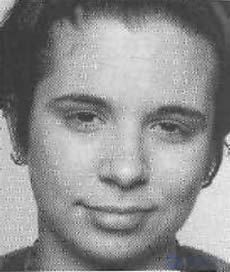
Comments
To leave a comment
Psychology of emotions
Terms: Psychology of emotions